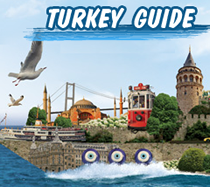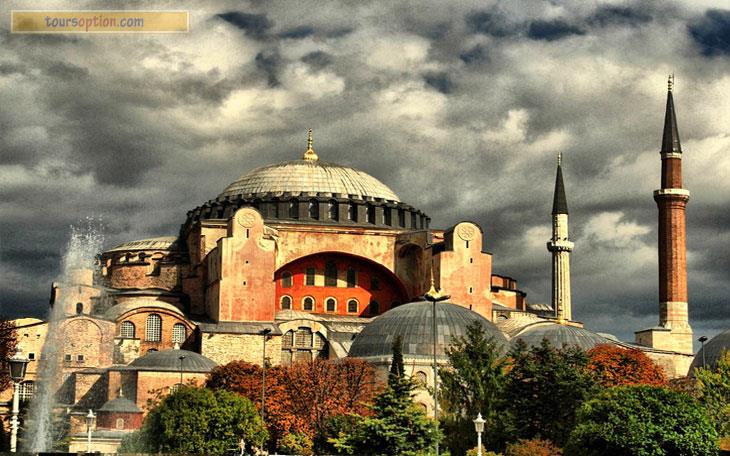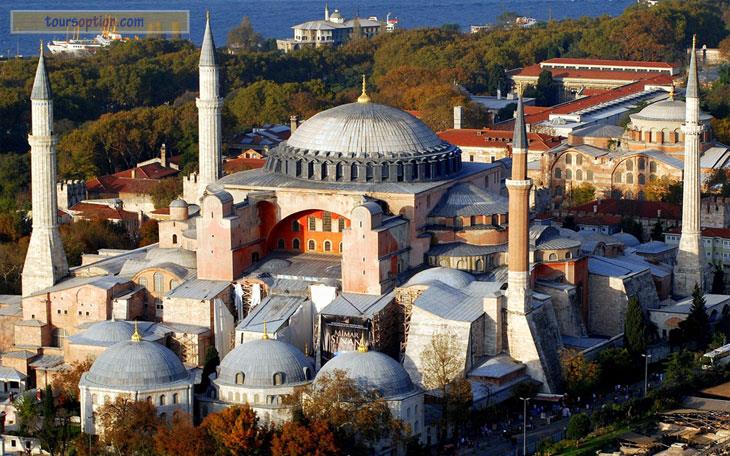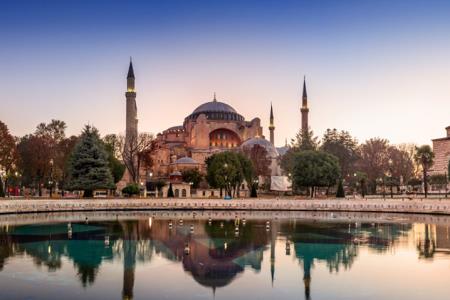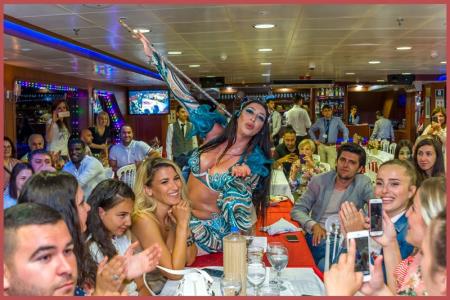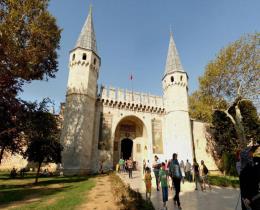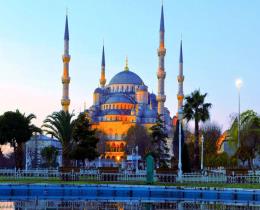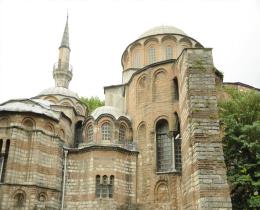In 1935, the first Turkish President and founder of the Republic of Turkey, Mustafa Kemal Atatürk, transformed the building into a museum. The carpets were removed and the marble floor decorations such as the Omphalion appeared for the first time in centuries, while the white plaster covering many of the mosaics was removed. Nevertheless, the condition of the structure deteriorated, and the World Monuments Fund placed Hagia Sophia on 1996 World Monuments Watch, and again in 1998. The building's copper roof had cracked, causing water to leak down over the fragile frescoes and mosaics. Moisture entered from below as well. Rising ground water had raised the level of humidity within the monument, creating an unstable environment for stone and paint. With the help of financial services company American Express, WMF secured a series of grants from 1997 to 2002 for the restoration of the dome. The first stage of work involved the structural stabilization and repair of the cracked roof, which was undertaken with the participation of the Turkish Ministry of Culture. The second phase, the preservation of the dome’s interior, afforded the opportunity to employ and train young Turkish conservators in the care of mosaics. By 2006, the WMF project was complete, though other areas of Hagia Sophia continue to require conservation.
Today, use of the complex as a place of worship (mosque or church) is strictly prohibited. However, in 2006, it was reported that the Turkish government allowed the allocation of a small room in the museum complex to be used as a prayer room for Christian and Muslim museum staff.
One of the mighty stone columns with metal clasps Hagia Sophia is one of the greatest surviving examples of Byzantine architecture. Of great artistic value was its decorated interior with mosaics and marble pillars and coverings. The temple itself was so richly and artistically decorated that Justinian proclaimed, "Solomon, I have outdone thee!" (Νενίκηκά σε Σολομών). Justinian himself had overseen the completion of the greatest cathedral ever built up to that time, and it was to remain the largest cathedral for 1,000 years up until the completion of the cathedral in Seville in Spain.
Justinian's basilica was at once the culminating architectural achievement of late antiquity and the first masterpiece of Byzantine architecture. Its influence, both architecturally and liturgically, was widespread and enduring in the Eastern Orthodox, Roman Catholic, and Muslim worlds alike. The largest columns are of granite, about 19 or 20 metres high and at least 1.5 metres in diameter; the largest weigh well over 70 tons apiece. Under Justinian's orders, eight Corinthian columns were disassembled from Baalbek, Lebanon and shipped to Constantinople for the construction of Hagia Sophia.
The vast interior has a complex structure. The nave is covered by a central dome 55.6 metres (182 ft 5 in) from floor level, supported in part by an arcade of 40 arched windows. Repairs to structure have left the dome somewhat elliptical – with the diameter varying between 31.24 m (102 ft 6 in) and 30.86 m (101 ft 3 in).
The dome is carried on four concave triangular pendentives that serve to transition from the circular base of the dome to its rectangular base.The weight of the dome passes through the pendentives to four massive piers at the corners; these were reinforced with buttresses during Ottoman times, under the guidance of the architect Mimar Sinan.
At the western entrance and eastern liturgical side, the arched openings are extended by half domes carried on smaller semi-domed exedras; a hierarchy of dome-headed elements built up to create a vast oblong interior, crowned by the main dome. Despite all of the aforementioned features, the weight of the dome remained a problem, requiring the addition of external buttresses.
Interior surfaces are sheathed with polychrome marbles, green and white with purple porphyry, and gold mosaics.The exterior, clad in stucco, was tinted yellow and red during a restorations in the 19th century on the direction of the Fossati architects.
Dome
Interior of the Hagia Sophia by John Singer Sargent, 1891 The dome of Hagia Sophia has spurred particular interest for many art historians, architects and engineers because of the innovative way the original architects envisioned the dome. The dome is supported by pendentives which had never been used before the building of this structure. The pendentive enables the dome to transition gracefully into the square shape of the piers below. The pendentives not only achieve a pleasing aesthetic quality, but they also restrain the lateral forces of the dome and allow the weight of the dome to flow downward.
The face of one of the cherub in the upper left corner, once covered by the Ottomans, is visible again. Although this design stabilizes the dome and the
surrounding walls and arches, the actual construction of the walls of Hagia Sophia weakened the overall structure. The bricklayers used more mortar than brick, which weakened the walls. The structure would have been more stable if the builders at least let the mortar cure before they began the next layer; however, they did not do this. When the dome was placed atop the building, the weight of the dome caused the walls to lean outward because of the wet mortar underneath. When Isidorus the Younger rebuilt the original dome, he had to first build up the interior of the walls so that they were vertical in order to support the weight of the new dome. Another probable change in the design of the dome when it was rebuilt was the actual height of the dome. Isidore the Younger raised the height of the dome by approximately six metres so that the lateral forces would not be as strong and the weight of the dome would flow more easily down the walls.
A second interesting fact about the original structure of the dome was how the architects were able to place forty windows around the base of the dome. Hagia Sophia is famous for the mystical quality of light that reflects everywhere in the interior of the nave, which gives the dome the appearance of hovering above the nave. This design is possible because the dome is shaped like a scalloped shell or the inside of an umbrella with ribs that extend from the top of the dome down to the base. These ribs allow the weight of the dome to flow between the windows, down the pendentives, and ultimately to the foundation.
The unique character of the design of Hagia Sophia shows how this structure is one of the most advanced and ambitious monuments of late antiquity. Two huge marble lustration urns were brought from Pergamon during the reign of Sultan Murad III. Originally from the Hellenistic period, they are carved from single blocks of marble.
Imperial Gate
The Imperial Gate was the main entrance between the exo- and esonarthex. It was reserved only for the emperor. The Byzantine mosaic above the portal depicts Christ and Emperor Leo VI the Wise.
Upper Gallery
The upper gallery is laid out in a horseshoe shape that encloses the nave until the apse. Several mosaics are preserved in the upper gallery, an area traditionally reserved for the empress and her court. The best-preserved mosaics are located in the southern part of the gallery.
Loge of the Empress
The Loge of the Empress is located in the centre of the upper enclosure, or gallery, of the Hagia Sophia. From there the empress and the court-ladies would watch the proceedings down below. A round, green stone marks the spot where the throne of the empress stood.
Marble Door
The Marble Door inside the Hagia Sophia is located in the southern upper enclosure, or gallery. It was used by the participants in synods, they entered and left the meeting chamber through this door.
One of the minarets (at southwest) was built from red brick while the other three were built from white limestone and sand stone; of which the slender one at northeast was erected by Sultan Bayezid II while the two larger minarets at west were erected by Sultan Selim II and designed by the famous Ottoman architect Mimar Sinan.
Minarets
One of the minarets (at southwest) was built from red brick while the other three were built from white limestone and sand stone; of which the slender one at northeast was erected by Sultan Bayezid II while the two larger minarets at west were erected by Sultan Selim II and designed by the famous Ottoman architect Mimar Sinan.
Decoration & Mosaics

Originally, under Justinian's reign, the interior decorations consisted of abstract designs of the marble slabs on the walls and mosaics on the curving vaults. Of these, one can still see the two archangels Gabriel and Michael in the spandrels of the bema. There were already a few figurative decorations, as attested by the eulogy of Paul the Silentiary. The spandrels of the gallery are revetted in opus sectile, showing patterns and figures of flowers and birds in precisely cut pieces of white marble set against a background of black marble. In later stages figurative mosaics were added, which were destroyed during the iconoclastic controversy (726–843). Present mosaics are from the post-iconoclastic period. The number of treasures, relics
and miracle-working, painted icons of the Hagia Sophia grew progressively richer into an amazing collection. Apart from the mosaics, a large number of figurative decorations were added during the second half of the 9th century: an image of Christ in the central dome; Orthodox saints, prophets and Church Fathers in the tympana below; historical figures connected with this church, such as Patriarch Ignatius; some scenes from the gospel in the galleries. Basil II let paint on each of the four pendentives a giant six-winged Cherub.The Ottomans covered their face with a golden halo, but in 2009 one of them has been restored to the original state.
Mosaics
Mosaics with geometric pattern decorate the upper imperial gallery The church was richly decorated with mosaics throughout the centuries. They either depicted the Virgin Mother, Jesus, saints, or emperors and empresses. Other parts were decorated in a purely decorative style with geometric patterns.
During the Sack of Constantinople in 1204, the Latin Crusaders vandalized valuable items in every important Byzantine structure of the city, including the golden mosaics of the Hagia Sophia. Many of these items were shipped to Venice, whose Doge, Enrico Dandolo, had organized the invasion and sack of Constantinople.
Following the building's conversion into a mosque in 1453, many of its mosaics were covered with plaster, due to Islam's ban on representational imagery. This process was not completed at once, and reports exist from the 17th century in which travellers note that they could still see Christian images in the former church. In 1847–49, the building was restored by two Swiss Italian brothers, Gaspare and Giuseppe Fossati, and Sultan Abdülmecid allowed them to also document any mosaics they might discover during this process. This work did not include repairing the mosaics and after recording the details about an image, the Fossatis painted it over again. This work included covering the previously uncovered faces of two seraphim mosaics located in the centre of the building. The building currently features a total of four of these images and two of them are restorations in paint created by the Fossatis to replace two images of which they could find no surviving remains. In other cases, the Fossatis recreated damaged decorative mosaic patterns in paint, sometimes redesigning them in the process. The Fossati records are the primary sources about a number of mosaic images now believed to have been completely or partially destroyed in an earthquake in 1894. These include a great mosaic of Christ Pantocrator in the dome, a mosaic over a now-unidentified Door of the Poor, a large image of a jewel-encrusted cross, and a large number of images of angels, saints, patriarchs, and church fathers. Most of the missing images were located in the building's two tympana. The Fossatis also added a pulpit (minbar)
and the four large medallions on the walls of the nave bearing the names of Muhammad and Islam's first caliphs.
Imperial Gate mosaic
Imperial Gate mosaics: located in the tympanum above the gate, used only by the emperors when entering the church. Based on style analysis, it has been dated to the late 9th or early 10th century. The emperor with a nimbus or halo could possibly represent emperor Leo VI the Wise or his son Constantine VII Porphyrogenitus bowing down before Christ Pantocrator, seated on a jeweled throne, giving His blessing and holding in His left hand an open book.The text on the book reads as follows: "Peace be with you. I am the light of the world". (John 20:19; 20:26; 8:12) On each side of
Christ's shoulders is a circular medallion: on His left the Archangel Gabriel , holding a staff, on His right His Mother Mary.
Southwestern entrance mosaic
Virgin and Child flanked by Justinian I and Constantine I Southwestern entrance mosaics, situated in the tympanum of the southwestern entrance, date from 944. They were rediscovered during the restorations of 1849 by Fossati. The Virgin sits on a throne without a back, her feet resting on a pedestal, embellished with precious stones. The Child Christ sits on her lap, giving His blessing and holding a scroll in His left hand. On her left side stands emperor Constantine in ceremonial attire, presenting a model of the city to Mary. The inscription next to him says: "Great emperor Constantine of the Saints". On her right side stands emperor Justinian I, offering a model of the Hagia Sophia. The medallions on both sides of the Virgin's head carry the monograms MP and ΘY, an abbreviation of "Mētēr" and "Theou", meaning "Mother of God".
Apse mosaics
Apse mosaic of the Theotokos (Virgin Mother and Child) Virgin and Child: this was the first of the post-iconoclastic mosaics. It was inaugurated on 29 March 867 by Patriarch Photius and the emperors Michael III and Basil I. This mosaic is situated in a high location on the half dome of the apse. Mary is sitting on a throne without a back, holding the Child Jesus on her lap. Her feet rest on a pedestal. Both the pedestal and the throne are adorned with precious stones.
These mosaics were believed to be a reconstruction of the mosaics of the 6th century that were previously destroyed during the iconoclastic era by the
Byzantines of that time, as represented in the inaugural sermon by the patriarch Photios. However, no record of figural decoration of Hagia Sophia exists before this time. The mosaics are set against the original golden background of the 6th century. The portraits of the archangels Gabriel and Michael (largely destroyed) in the bema of the arch also date from the 9th century.
Emperor Alexander mosaic
The Emperor Alexander mosaic is not easy to find for the first-time visitor, located in the second floor in a dark corner of the ceiling. It depicts Emperor Alexander in full regalia, holding a scroll in his right hand and a globus cruciger in his left. A drawing by Fossati showed that the mosaic survived until 1849, and that Thomas Whittemore, founder of the Byzantine Institute of America who was granted permission to preserve the mosaics, assumed that it had been destroyed in the earthquake of 1894. Eight years after his death, the mosaic was discovered in 1958 largely through the researches of Robert Van Nice. Unlike most of the other mosaics in Hagia Sophia, which had been covered over by ordinary plaster, the Alexander mosaic was simply painted over and reflected the surrounding mosaic patterns and thus was well hidden. It was duly cleaned by the Byzantine Institute's successor to Whittemore, Paul A. Underwood.
Empress Zoe mosaics
Empress Zoe mosaics The Empress Zoe mosaics on the eastern wall of the southern gallery date from the 11th century. Christ Pantocrator, clad in the dark blue robe (as always the custom in Byzantine art), is seated in the middle against a golden background, giving His blessing with the right hand and holding the Bible in His left hand. On either side of His head are the monograms IC and XC, meaning Iēsous Khristos. He is flanked by Constantine IX Monomachus and Empress Zoe, both in ceremonial costumes. He is offering a purse, as symbol of the donation he made to the church, while she is holding a scroll, symbol of the donations she made. The inscription over the head of the emperor says : "Constantine, pious emperor in Christ the God, king of the Romans, Monomachus". The inscription over the head of the empress reads as follows : "Zoë, the very pious Augusta". The previous heads have been scraped off and replaced by the three present ones. Perhaps the earlier mosaic showed her first husband Romanus III Argyrus or her adopted son Michael IV. Another theory is that these mosaics were made for an earlier emperor and empress, with their heads changed into the present ones.
Comnenus mosaics
Comnenus mosaic The Comnenus mosaics, equally located on the eastern wall of the southern gallery, date from 1122. The Virgin Mary is standing is the middle, depicted, as usual in Byzantine art, in a dark blue gown. She holds the Child Christ on her lap. He gives His blessing with His right hand while holding a scroll in His left hand. On her right side stands emperor John II Comnenus, represented in a garb embellished with precious stones. He holds a purse, symbol of an imperial donation to the church. Empress Irene stands on the left side of the Virgin, wearing ceremonial garments and offering a document. Their eldest son Alexius Comnenus is represented on an adjacent pilaster. He is shown as a beardless youth, probably
representing his appearance at his coronation aged seventeen. In this panel one can already see a difference with the Empress Zoe mosaics that is one century older. There is a more realistic expression in the portraits instead of an idealized representation. The empress is shown with plaited blond hair, rosy cheeks and grey eyes, revealing her Hungarian descent. The emperor is depicted in a dignified manner.
Deësis mosaic
Detail of Deësis mosaic The Deësis ('Δέησις' in Greek, meaning Entreaty) mosaic probably dates from 1261. It was commissioned to mark the end of 57 years of Roman Catholic use and the return to the Orthodox faith. It is the third panel situated in the imperial enclosure of the upper galleries. It is widely considered the finest in Hagia Sophia, because of the softness of the features, the humane expressions and the tones of the mosaic. The style is close to that of the Italian painters of the late 13th or early 14th century, such as Duccio. In this panel the Virgin Mary and John the Baptist
(Ioannes Prodromos), both shown in three-quarters profile, are imploring the intercession of Christ Pantocrator for humanity on Judgment Day. The bottom part of this mosaic is badly deteriorated. This mosaic is considered as the beginning of the Renaissance in Byzantine pictorial art.
Northern tympanon mosaics
Mosaic in the northern tympanon depicting Saint John Chrysostom The northern tympanon mosaics feature various saints. They have been able to survive due to the very high and unreachable location. They depict Saints John Chrysostom and Ignatius the Younger standing, clothed in white robes with crosses, and holding richly jewelled Holy Bibles. The names of each saint is given around the statues in Greek, in order to enable an identification for the visitor. The other mosaics in the other tympani have not survived probably due to the frequent earthquakes as opposed to any deliberate destruction by the Ottoman conquerors.
20th-century restoration
The interior of the dome undergoing restoration A large number of mosaics were uncovered in the 1930s by a team from the Byzantine Institute of America led by Thomas Whittemore. The team chose to let a number of simple cross images remain covered by plaster, but uncovered all major mosaics
found.
Because of its long history as both a church and a mosque, a particular challenge arises in the restoration process. The Christian iconographic mosaics are being gradually uncovered. However, in order to do so, important, historic Islamic art would have to be destroyed. Restorers have attempted to maintain a balance between both Christian and Islamic cultures. In particular, much controversy rests upon whether the Islamic calligraphy on the dome of the cathedral should be removed, in order to permit the underlying Pantocrator mosaic of Christ as Master of the World, to be exhibited (assuming the mosaic still exists).

 English
English Español
Español Deutsch
Deutsch عربي
عربي  Русский
Русский